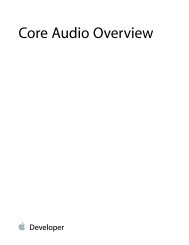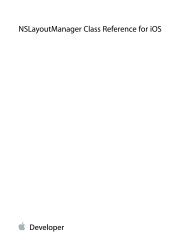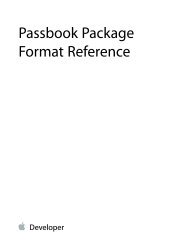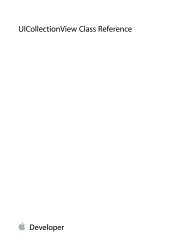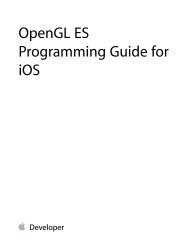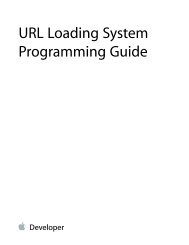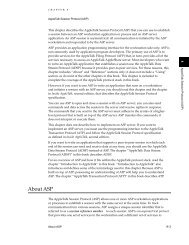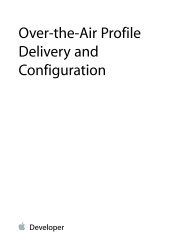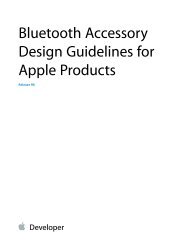In-App Purchase Programming Guide - Apple Developer
In-App Purchase Programming Guide - Apple Developer
In-App Purchase Programming Guide - Apple Developer
Create successful ePaper yourself
Turn your PDF publications into a flip-book with our unique Google optimized e-Paper software.
Designing Your <strong>App</strong>’s Products<br />
Creating Products in iTunes Connect<br />
Creating Products in iTunes Connect<br />
Before you start coding, you need to configure products in iTunes Connect for your app to interact with. As<br />
you develop your app, you can add and remove products and refine or reconfigure your existing products.<br />
Products are reviewed when you submit your app as part of the app review process. Before users can buy a<br />
product, it must be approved by the reviewer and you must mark it as “cleared for sale” in iTunes Connect.<br />
See <strong>In</strong>-<strong>App</strong> <strong>Purchase</strong> Configuration <strong>Guide</strong> for iTunes Connect .<br />
Product Types<br />
Product types let you use <strong>In</strong>-<strong>App</strong> <strong>Purchase</strong> in a range of apps by providing several different product behaviors.<br />
<strong>In</strong> iTunes Connect, you select one of the following product types:<br />
●<br />
●<br />
●<br />
●<br />
●<br />
Consumable products. Items that get used up over the course of running your app. Examples include<br />
minutes for a Voice over IP app and one-time services such as voice transcription.<br />
Non-consumable products. Items that remain available to the user indefinitely on all of the user’s devices.<br />
They’re made available to all of the user’s devices. Examples include content, such as books and game<br />
levels, and additional app functionality.<br />
Auto-renewable subscriptions. Episodic content. Like non-consumable products, auto-renewable<br />
subscriptions remain available to the user indefinitely on all of the user’s devices. Unlike non-consumable<br />
products, auto-renewable subscriptions have an expiration date. You deliver new content regularly, and<br />
users get access to content published during the time period their subscription is active. When an<br />
auto-renewable subscription is about to expire, the system automatically renews it on the user’s behalf.<br />
Non-renewable subscriptions. Subscriptions that don’t involve delivering episodic content. Examples<br />
include access to a database of historic photos or a collection of flight maps. It’s your app’s responsibility<br />
to make the subscription available on all of the user’s devices and to let users restore the purchase. This<br />
product type is often used when your users already have an account on your server that you can use to<br />
identify them when restoring content. Expiration and the duration of the subscription are also left to your<br />
app (or your server) to implement and enforce.<br />
Free subscriptions. A way to put free subscription content in Newsstand. After a user signs up for a free<br />
subscription, the content is available on all devices associated with the user’s <strong>App</strong>le ID. Free subscriptions<br />
don’t expire and can be offered only in Newsstand-enabled apps.<br />
2013-10-22 | Copyright © 2013 <strong>App</strong>le <strong>In</strong>c. All Rights Reserved.<br />
9



